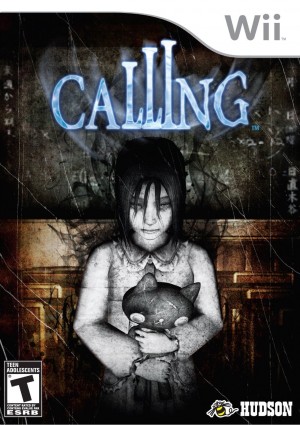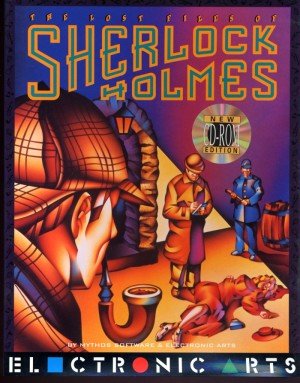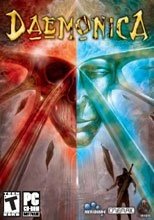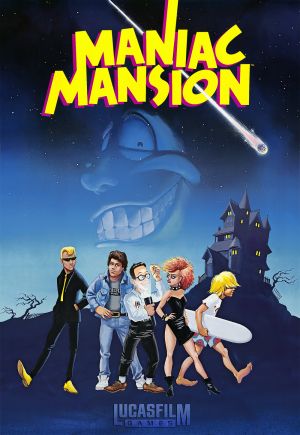Review for Calling

It’s exaggerating to say that if you’ve seen one Japanese horror, you’ve seen them all. It’s far less a stretch to say that if you play Hudson’s Calling, you’ll get a little bit of every J-horror in one. This Nintendo Wii adventure shares more than a few similarities with technology-based movie remakes like The Ring, One Missed Call, and Pulse. Shine your flashlight a little deeper into its darkened hallways, and you’ll surely see resemblances to games such as Clock Tower and Fatal Frame. Everywhere you look, you’ll discover more influences than you can shake a stick at – which is exactly what you’ll spend your time doing when its many spectral inhabitants come looking for you. Unfortunately, these comparisons serve largely to highlight how inferior Calling is to its thematic contemporaries, both as a disturbing atmospheric experience and as a game.
The letdown is all the more disappointing because its unrealized potential is so evident. Although this game could be classified as a “survival horror”, it borrows a page (here we go again) from Silent Hill: Shattered Memories in giving the player no weapons, no means of self-defense; just a flashlight, a map, and whatever courage you can muster. Oh, and a phone. As its title suggests, Calling’s main claim to fame is a cell phone tied directly to the Wiimote functions, enabling you to take photos, record ghostly voice traces, communicate with both the living and the dead, and even supernaturally transport yourself instantly to other phones. It’s a neat idea, and does manage to represent one of the game’s more positive elements, but it’s simply not enough to keep carrying what is otherwise a plodding, derivative, poorly-designed adventure.
The story opens with a cinematically-deprived introduction to a mysterious chat room called the “Black Page”, which is every bit as exciting as it sounds. Reading through simple text scrolling down a plain dark background, you’ll begin to learn that this website is linked to numerous unexplained deaths over the years, including a trio of misbehaving high school girls and a rash of hospital fatalities among staff and patients alike, along with a reporter who disappeared while investigating the incidents. A visitor counter looms ominously as the conversation proceeds, and as the phones simultaneously ring for each person involved in the chat, that counter begins to go up…
As gameplay begins with a rushed tutorial level, it becomes apparent that you’ve been drawn into a world between life and death called the “Mnemonic Abyss”. Cobbled together from the memories of its victims, the world looks and feels real enough, and players themselves are still more or less alive. Staying that way is an entirely different proposition, however, as there seems to be no way out, and the ghostly residents of this netherworld seem eager to welcome you into their ranks.
You’ll end up controlling four different characters throughout the game, most of it as a 21-year old student named Rin (who looks like she’s about 13) and a magazine editor named Myoko, taking only brief turns as a nerdy high schooler and a grieving elderly woman for a change of pace. None of the characters know each other, and you’re dropped into their roles with no background, leaving you to piece together their stories through your actions and the many scattered documents lying around that fill in important details. You’ll also flesh out (so to speak) the histories of the ghosts you encounter, discovering how and why they came to be involved, particularly one lonely little girl who’d be adorable if she weren’t so terrifying.
These characters, whether living or dead, are quite nicely developed over time, and their tales are often compelling as you wend through the many disjointed fragments of their past. It’s fairly confusing at first, as the staggered nature of revealed memories jumps around from person to person, timeline to timeline. Eventually the connections do start to form, though, and some deeper themes emerge, such as abandonment and vengeance, redemption and forgiveness. Though a few characters seem tacked on for no obvious reason, and the narrative is perhaps a bit too melodramatic for its own good at times, in general there’s a touching story worth telling here. Too bad it’s so hopelessly wasted away, hidden in the oppressive darkness.
The dark is perhaps the real star of Calling, as the vast majority of the game is spent roaming in eerie blackness. (Apparently few of the victims’ memories included light.) Obviously this ratchets up the tension at first, as it’s easy to be spooked by what you can’t see, especially when you know that anything going “bump” in this night has evil intentions towards you. Even the flashlight only brightens a narrow path in front of you, so your perspective is almost always limited. A few scenes are lit normally and one is even amplified in a hazy, dreamlike way, providing a welcome contrast from the norm, but then it’s quickly back into the black. Unfortunately, the relentless dreariness gets old fast, and very little is ever done with this opportunity, as you’ll rarely see anything frightening in your dimly-lit peripheral. Instead, the game throws random cheap scares at you, like sudden images flashing almost imperceptibly onscreen with no explanation at all.
Far worse is the fact that the designers have made the darkness an obstacle in its own right. Rather than interject a few horrifying moments of blindness, here you’ll routinely lose your flashlight, run out of batteries, or find yourself otherwise ill-equipped to continue. Yet that angle goes nowhere, either, as nothing worse than normal happens during these periods. You’re merely left to continue doing exactly what you’ve been doing already: trudging aimlessly around looking for the next object or area the game suddenly deems important – only this time, even if you can plainly see what you’re looking at, anything you try to interact with results in a frustrating “You can’t see well in the dark.” Perhaps it’s fitting that even the commentary offers no illumination, but all this accomplishes, besides growing annoyance, is the need to backtrack once your light is working again to look at everything once more.
Even then, the effort is rarely rewarded. You’ll seldom find anything interactive in your extensive wandering, and when you do, it’s often nothing more than a series of empty drawers or cupboards, though for some reason your character will always feel the need to comment inanely about plants. Occasionally you will find a necessary key or dropped cell phone (which constantly need to be replaced each time you warp), and even some odd inventory items that are used automatically when required, but thorough exploration typically just yields more of the same. You can’t afford to simply pass it all by, regrettably, as you never know when a vital journal page will magically appear where nothing existed before, so you’ve got to keep checking, re-checking, and checking some more when you inevitably get stuck.
Calling is not a difficult game by any means, but you will certainly find yourself unsure of how to proceed at times. There are a few logic puzzles to solve, from misaligned tumblers to safe combinations to decipher, and even a slider-type challenge thrown in for good measure. As poorly integrated as these generally are, you’ll likely sail through them with ease (with the possible exception of one computer password’s ridiculously unintuitive solution). What will trip you up – repeatedly – is a horrendous lack of direction. This game continually leaps from one signposting extreme to another. One minute a black cat or inexplicably non-aggressive ghost will appear to lead you directly to your next objective, only to be followed by a seemingly endless search for unknown triggers you can’t possibly anticipate. Though progress is strictly linear, you can move freely in some very open-ended environments, so it’s easy to wrack up the mileage in quest of nothing in particular, or overlook one tiny detail that could be concealed anywhere.
As you’re doing all this legwork, the nunchuck handles movement while the remote controls the first-person view by moving a small cursor to the screen edges. For the most part this works pretty well, though the pointer can get finicky, and it would have been much more natural to use the thumbstick for turning. (Even with ghosts chasing you at times, this is not a game that ever demands strafing.) A map showing the current location’s floor layout is always available, but it doesn’t provide any quick travel options to speed things along. Interaction is simple point-and-click, the cursor changing as the remote vibrates over anything you can manipulate (take that, PC gamers!) There’s a bit of motion-controlled activity involved, like opening and closing doors, but these controls are cumbersome and add nothing but another layer of irritation to the experience.
The bulk of the motion control is reserved for action sequences. I know, this is the part where many adventure gamers bow out, but Calling is unique in its approach to “survival horror” gameplay. The good news is, this method requires no skill at all. The bad news is, it requires no skill at all. Obviously the potential benefit depends on which side of the fence you’re on, but while it does mean that more dexterity-challenged gamers might be able to play the game, it doesn’t do much to ensure they’ll want to.
While danger could theoretically be waiting around any corner, in reality (Mnemonic Abyss reality, anyway) your confrontations are entirely scripted, come few and far between, and are quite easy to escape. Many of these sequences are one-time attacks: as a ghost grabs at you, you simply wave the remote frantically to make them lose their grip, which often occurs in a matter of seconds. Alternatively, an icon will flash onscreen very briefly, and pressing the “A” button will end the encounter instantly. This is a bizarre choice, as the position of the button is awkwardly placed for a split-second, mid-waggle tap. The only time you’ll really need to bother, however, is in the extended conflicts. For reasons known only to Hudson, some ghosts will keep trying to attack you for a timed duration. There’s no way to know which will do so ahead of time or gauge your progress mid-conflict, but even the longest of these go on only for about a minute.
You can die during these “fight” scenes, as a Horror Meter appears and begins to rise, and if it reaches a critical point, it’s game over. But that only happened to me once, and only because it occurred in a tightly-confined area, where most happen with enough maneuvering room to kill off some time by moving around between grapples. A few times you’ll be forced to flee altogether, as Calling’s ghosts suddenly become unable to overcome worldly roadblocks like doors and stairs in the heat of battle. There’s also one brief stealth scenario and on rare occasions there’s a particularly tough sequence – one requiring a quick dialing hand as you make a phone call under duress, and a single ghost you can’t flee or shake if caught. You may find yourself repeating a couple of these, but save points are always nearby, so you won’t ever lose much time.
The problem is that, like just about everything else in Calling, this “action” simply isn’t much fun, or even very frightening. It’s startling the first few times, but then panic gives way to routine, and eventually to resentment. For a while it’s a welcome break from the monotony of exploring bland environments, but it does little to provide any genuine thrills. In fact, Calling is far more effective when it focuses its attention on implied horror instead of superficial scare tactics. When you find your first cell phone, you’ll get warning calls from its owner’s ghost, who’s closing in on your location and intends to get it back. That’s deliciously atmospheric stuff. And any time you can record audio, you’re alerted with white noise, which alone is infinitely more haunting than the ridiculous and out-of-place “boo!” moments like hands lurching out of vending machines, dolls springing to life, or thunderous hands pounding their way through metal doors. These events are admittedly creepy in the moment, but are too sparse to matter and make no sense in the storyline. Their singleminded purpose clearly echo one ghost’s taunts early on: “Gotcha!”
Not that you’d be able to see them very well if they did, the graphics do little to foster any fear or suspense on their own. The Wii is graphically underwhelming to begin with, but even the environments themselves are dull. Whether it’s an empty school or hospital with nearly-identical floors, a few small rooms and apartments, or a beauty salon, it’s all very humdrum apart from that whole darkness thing. The only indication that you’re not in the regular world are doorways that lead into a swirling void, and surely the artists could have dreamed up something to instill a bit of surreal horror. Oh wait, there’s a single door that’s covered in snaking black hair. (The Grudge says hi.) Character models are adequate if a little disproportioned, but at least the ghosts themselves are reasonably spooky.
Good audio is often vital in effectively conveying horror, but Calling offers decidedly mixed results. Strangely, the game foregoes any music for the most part. A few brief discordant-sounding pieces play at key moments, but otherwise all is silent. I’m in favour of that approach, but here so little happens so much of the time, it comes off as simply… uhh… dead air. Sound effects occur intermittently in the quiet darkness around you, and will likely make your heart skip a beat the first few times, at least until you start hearing the same ones repeating but never signify anything tangible. The doors do a lot of creaking, but otherwise there isn’t much to hear, though for some reason the ghosts cause noisy footfall when they walk. Go figure. The voicework is passable, though you’ll be thankful there isn’t more of it.
Where this game does make inspired use of sound is in the Wiimote itself. Any sounds connected to your cell phone play not from your TV, but from the remote’s own built-in speaker. It’s a gimmick, sure, but a clever one. Ghostly callers sound more haunting when voices crackle through the distorted remote sound in your hand, and it helps create a genuine illusion that the device is an integral part of your adventure. If only it weren’t such a nuisance to dial, the remote-as-cell-phone would have been a perfect companion in this game.
Depending on how long you spend feeling clueless and lost, Calling should take between 10-12 hours to complete. Really complete, I mean, not the mid-ending that defies all logic. I can only guess that Calling was originally designed in two distinct phases, as about three-fifths of the way through you’ll reach what seems to be the finale. Immediately, however, you’re told you’ve unlocked a new “chapter”, but instead of simply carrying you through the rest of the way, you’re sent all the way back to the beginning. You can skip any segment you’ve already played, with the threatening message that you’re missing part of the story, but the two scenarios I repeated showed little had changed, if anything. There are subtle differences in the all-new section that further suggest a separate production from the rest, like an automated notepad for phone numbers, which would have been incredibly handy from the start. Whatever the reason, I’m glad the follow-up was included, as it does a more cohesive job of tying up the various storylines, and even comes with a new ending if you stick with it all the way through the final credit sequence.
Whether you want to trouble yourself to reach that point is far less certain. Calling does have its frightening moments, and diehard fear fans are bound to find something here to make their skin crawl occasionally. And for anyone who struggles with skill-based action games, this title represents an opportunity to dabble in survival horror, more or less adventure-style. Anyone can shake a remote, right? Even so, while the tragic backstory is worth seeing through and the cell phone concept is novel for a while, all that’s left beyond that is a poorly-paced exploration in the dark, punctuated by a series of startling yet repetitive ghost encounters. So unless that’s your idea of a good time, this is one number that’s probably not worth picking up.






























